#student nonviolent coordinating committee (sncc)
Explore tagged Tumblr posts
Text
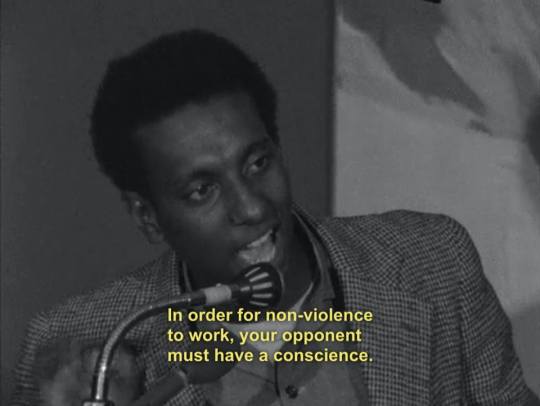

[ID: Two black and white photos of Kwame Ture/Stokely Carmichael, a young Black man, saying into a microphone with a sardonic expression, "In order for non-violence to work, your opponent must have a conscience. The United States has none, has none." End ID.]
#Kwame Ture#Stokely Carmichael#Pacifism#anti colonialism#antifashism#antifascism#antifashist#antifascist#got tired of seeing the inaccessible version knowing there's doznes of IDs buried in the comments#described images#accessible photos#Black Panthers#Black Power#Student Nonviolent Coordinating Committee#SNCC#non-violence#peace#united states#politics#ferguson#From the river to the sea Palestine will be free#free Palestine#free gaza#Gaza#Palestine#BLM#Black Lives Matter#Landback
6K notes
·
View notes
Photo
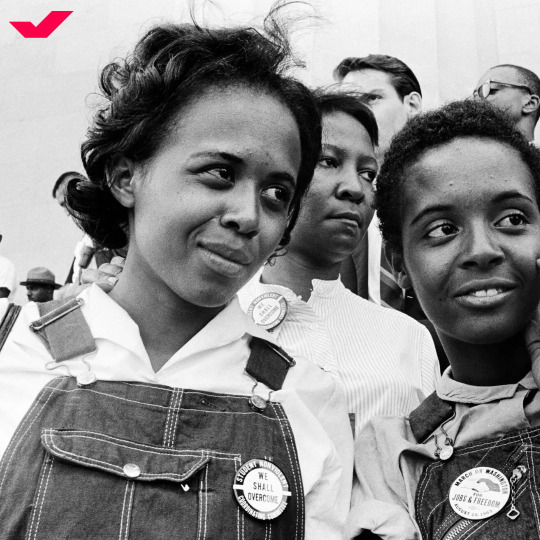
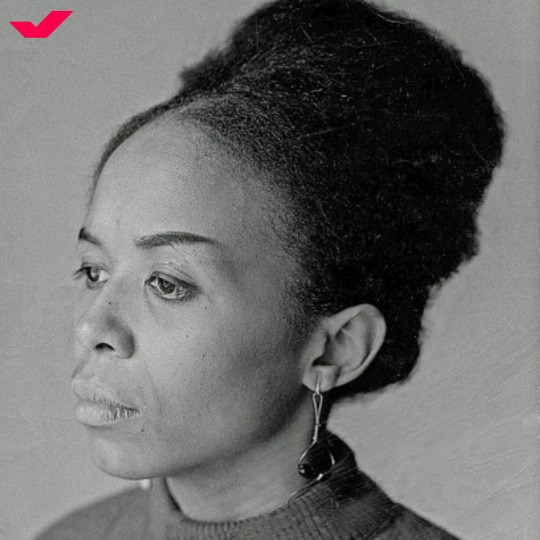
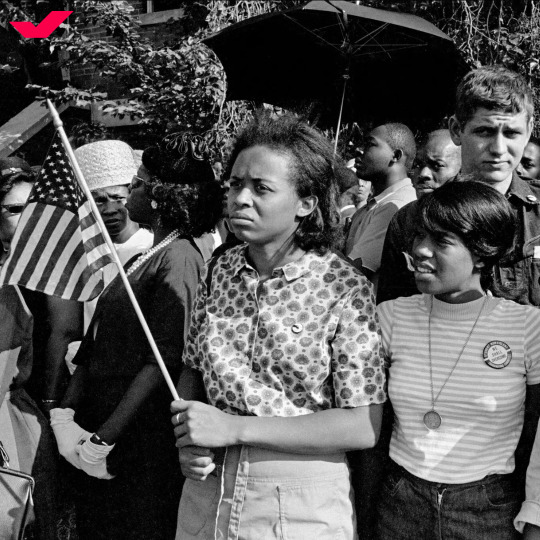
We are saddened to hear about the passing of Dorie Ann Ladner, lifelong voting rights activist. 🕊️🗳️
Ms. Ladner participated in every major civil rights protest of the 1960s, including the March on Washington and the march from Selma to Montgomery, Alabama. She was a key organizer in her home state of Mississippi, with contributions to the NAACP and Student Nonviolent Coordinating Committee. In June 1964, she launched a volunteer campaign called “Mississippi Freedom Summer,” with a goal of registering as many Black voters as possible.
We remember and honor Dorie through the words of her sister and fellow activist, Joyce Ladner: as someone who “fought tenaciously for the underdog and the dispossessed,” and “left a profound legacy of service.”
#dorie ladner#dorie ann ladner#voting rights#civil rights#women's history month#mississippi#naacp#sncc#student nonviolent coordinating committee#black voters#black voter#activist#1960s
367 notes
·
View notes
Text

Gordon Parks (photograph), Stokely Carmichael in SNCC Office, (gelatin silver print), 1967, Edition of 15 [Rhona Hoffman Gallery, Chicago, IL. © Gordon Parks / The Gordon Parks Foundation, Pleasantville, NY]
#art#photography#stokely carmichael#kwame ture#gordon parks#student nonviolent coordinating committee#sncc#rhona hoffman gallery#gordon parks foundation#1960s
43 notes
·
View notes
Text

National Museum of African American History and Culture, Smithsonian Institute
The Freedom Singers Concert ticket
#the freedom singers#SNCC#student nonviolent coordinating committee#civil rights movement#black history#black folk#struggle folk#protest folk#folk revival#60s folk#60s#american history#photos
4 notes
·
View notes
Text
#ella josephine baker#ella baker#civil rights activist#human rights advocate#grassroots organizing#leadership philosophy#mentorship#student nonviolent coordinating committee (sncc)#w. e. b. du bois#thurgood marshall#a. philip randolph#martin luther king jr.#diane nash#stokely carmichael#bob moses#radical democracy#social justice#racial equality#gender equality#civil rights movement
5 notes
·
View notes
Text
John Lewis passed away shortly before the 2020 election. In the 1960s he was one of the "Big Six" leaders of the Civil Rights movement, along side Dr. King. He was the Chair of the movement's youth wing, Student Nonviolent Coordinating Committee (SNCC). In 1965 Lewis helped lead marches for voting rights from Selma to Montgomery. On the Edmund Pettus Bridge they were met by Alabama State Troopers who beat the marchers, they fractured Lewis' skull and he almost died. In later life John Lewis became a Congressman from Georgia. In Congress Lewis was the voice of the Democratic Party's conscience, speaking out for gay rights, Soviet Jews, gun control, immigration reform, a strong critic of George W. Bush and Donald Trump. He was arrested at protests and sit ins as a member of Congress, he believed as he often said in getting into "Good Trouble"
This election, go and vote, for the people who gave blood to make it possible for every American to have the right.
#John Lewis#Politics#US politics#American politics#civil rights#election 2024#vote#voting#history#black history
160 notes
·
View notes
Text

Danny Lyon Sit-in by Members of the Student Nonviolent Coordinating Committee (SNCC) at a Segregated Restaurant, Atlanta 1963
338 notes
·
View notes
Text

Jamil Abdullah al-Amin (born Hubert Gerold Brown; October 4, 1943), is an American human rights activist, Muslim cleric, African separatist, and convicted murderer who was the fifth chairman of the Student Nonviolent Coordinating Committee (SNCC) in the 1960s. Best known as H. Rap Brown, he served as the Black Panther Party's minister of justice during a short-lived (six months) alliance between SNCC and the Black Panther Party.
He is perhaps known for his proclamations during that period, such as that "violence is as American as cherry pie", and that "If America don't come around, we're gonna burn it down." He is also known for his autobiography, Die Nigger Die! He is currently serving a life sentence for murder following the shooting of two Fulton County, Georgia, sheriff's deputies in 2000.

Brown's activism in the civil rights movement included involvement with the Student Nonviolent Coordinating Committee (SNCC). Brown was introduced into SNCC by his older brother Ed. He first visited Cambridge, Maryland with Cleveland Sellers in the summer of 1963, during the period of Gloria Richardson's leadership in the local movement. He witnessed the first riot between whites and blacks in the city over civil rights issues, and was impressed by the local civil rights movement's willingness to use armed self-defense against racial attacks.
Brown later organized for SNCC during the 1964 Mississippi Freedom Summer, while transferring to Howard University for his studies. Representing Howard's SNCC chapter, Brown attended a contentious civil rights meeting at the White House with President Lyndon B. Johnson during the Selma crisis of 1965 as Alabama activists attempted to march for voting rights.
Major federal civil rights legislation was passed in 1964 and 1965, including the Voting Rights Act, to establish federal oversight and enforcement of rights. In 1966, Brown organized in Greene County, Alabama to achieve African voter registration and implementation of the recently passed Voting Rights Act.
Elected SNCC chairman in 1967, Brown continued Stokely Carmichael's fiery support for "Black Power" and urban rebellions in the Northern ghettos.
During the summer of 1967, Brown toured the nation, calling for violent resistance to the government, which he called "The Fourth Reich". "Negroes should organize themselves", he told a rally in Washington, D.C., and "carry on guerilla warfare in all the cities." They should, "make the Viet Cong look like Sunday school teachers." He declared, "I say to America, Fuck it! Freedom or death!"

In this period, Cambridge, Maryland had an active civil rights movement, led by Gloria Richardson. In July 1967 Brown spoke in the city, saying "It's time for Cambridge to explode, baby. Black folks built America, and if America don't come around, we're going to burn America down." Gunfire reportedly broke out later, and both Brown and a police officer were wounded. A fire started that night and by the next day, 17 buildings were destroyed by an expanding fire "in a two-block area of Pine Street, the center of African-American commerce, culture and community." Brown was charged with inciting a riot, due to his speech.
Brown was also charged with carrying a gun across state lines. A secret 1967 FBI memo had called for "neutralizing" Brown. He became a target of the agency's COINTELPRO program, which was intended to disrupt and disqualify civil rights leaders. The federal charges against him were never proven.
He was defended in the gun violation case by civil rights advocates Murphy Bell of Baton Rouge, the self-described "radical lawyer" William Kunstler, and Howard Moore Jr., general counsel for SNCC. Feminist attorney Flo Kennedy also assisted Brown and led his defense committee, winning support for him from some chapters of the National Organization for Women.
The Cambridge fire was among incidents investigated by the 1967 Kerner Commission. But their investigative documents were not published with their 1968 report. Historian Dr. Peter Levy studied these papers in researching his book Civil War on Race Street: The Civil Rights Movement in Cambridge, Maryland (2003). He argues there was no riot in Cambridge. Brown was documented as completing his speech in Cambridge at 10 pm July 24, then walking a woman home. He was shot by a deputy sheriff allegedly without provocation. Brown was hastily treated for his injuries and secretly taken by supporters out of Cambridge.
Later that night a small fire broke out, but the police chief and fire company did not respond for two hours. In discussing his book, Levy has said that the fire's spread and ultimate destructive cost appeared to be due not to a riot, but to the deliberate inaction of the Cambridge police and fire departments, which had hostile relations with the African community. In a later book, Levy notes that Brice Kinnamon, head of the Cambridge police department, said that the city had no racial problems, and that Brown was the "sole" cause of the disorder, and it was "a well-planned Communist attempt to overthrow the government."
While being held for trial, Brown continued his high-profile activism. He accepted a request from the Student Afro-American Society of Columbia University to help represent and co-organize the April 1968 Columbia protests against university expansion into Harlem park land in order to build a gymnasium.
He also contributed writing from jail to the radical magazine Black Mask, which was edited and published by the New York activist group Up Against the Wall Motherfucker. In his 1968 article titled "H. Rap Brown From Prison: Lasima Tushinde Mbilashika", Brown writes of going on a hunger strike and his willingness to give up his life in order to achieve change.
Brown's trial was originally to take place in Cambridge, but there was a change of venue and the trial was moved to Bel Air, Maryland, to start in March 1970. On March 9, 1970, two SNCC officials, Ralph Featherstone and William ("Che") Payne, died on U.S. Route 1 south of Bel Air, when a bomb on the front floorboard of their car exploded, killing both occupants. The bomb's origin is disputed: some say the bomb was planted in an assassination attempt, and others say Payne was carrying it to the courthouse where Brown was to be tried. The next night, the Cambridge courthouse was bombed

Brown disappeared for 18 months. He was posted on the Federal Bureau of Investigation's Ten Most Wanted List. He was arrested after a reported shootout with officers in New York City following an alleged attempted robbery of a bar there. He was convicted of robbery and served five years (1971–76) in Attica Prison in western New York state. While in prison, Brown converted to Islam. He formally changed his name from Hubert Gerold Brown to Jamil Abdullah al-Amin.
After his release, he moved to Atlanta, Georgia, where he opened a grocery store. He became an imam, a Muslim spiritual leader, in the National Ummah, one of the nation's largest African Muslim groups. He also was a community activist in Atlanta's West End neighborhood. He preached against drugs and gambling. It has since been suggested that al-Amin changed his life again when he became affiliated with the "Dar ul-Islam Movement"

On May 31, 1999, al-Amin was pulled over while driving in Marietta, Georgia by police officer Johnny Mack for a suspected stolen vehicle. During a search, al-Amin was found to have in his pocket a police badge. He also had a bill of sale in his pocket, explaining his possession of the stolen car, and he claimed that he had been issued an honorary police badge by Mayor John Jackson, a statement which Jackson verified. Despite this, al-Amin was charged with speeding, auto theft and impersonating a police officer.
On March 16, 2000, in Fulton County, Georgia, Sheriff's deputies Ricky Kinchen and Aldranon English went to al-Amin's home to execute an arrest warrant for failing to appear in court over the charges. After determining that the home was unoccupied, the deputies drove away and were shortly passed by a black Mercedes headed for the house. Kinchen (the more senior deputy) noted the suspect vehicle, turned the patrol car around, and drove up to the Mercedes, stopping nose to nose. English approached the Mercedes and told the single occupant to show his hands. The occupant opened fire with a .223 rifle. English ran between the two cars while returning fire from his handgun, and was hit four times. Kinchen was shot with the rifle and a 9 mm handgun.
The next day, Kinchen died of his wounds at Grady Memorial Hospital. English survived his wounds. He identified al-Amin as the shooter from six photos he was shown while recovering in the hospital[citation needed] Another source said English identified him shortly before going into surgery for his wounds.
After the shootout, al-Amin fled Atlanta, going to White Hall, Alabama. He was tracked down by U.S. Marshals who started with a blood trail at the shooting site, and arrested by law enforcement officers after a four-day manhunt. Al-Amin was wearing body armor at the time of his arrest. He showed no wounds. Officers found a 9 mm handgun near his arrest site. Firearms identification testing showed that this was used to shoot Kinchen and English, but al-Amin's fingerprints were not found on the weapon. Later, al-Amin's black Mercedes was found with bullet holes in it.
His lawyers argued he was innocent of the shooting. Defense attorneys noted that al-Amin's fingerprints were not found on the murder weapon, and he was not wounded in the shooting, as one of the deputies said the shooter was. A trail of blood found at the scene was tested and did not belong to al-Amin or either of the deputies. A test by the state concluded that it was animal blood, but these results have been disputed because there was no clear chain of custody to verify the sample and testing process. Deputy English had said that the killer's eyes were gray, but al-Amin's are brown.
At al-Amin's trial, prosecutors noted that he had never provided an alibi for his whereabouts at the time of the shootout, nor any explanation for fleeing the state afterward. He also did not explain why the weapons used in the shootout were found near him during his arrest.
On March 9, 2002, nearly two years after the shootings, al-Amin was convicted of 13 criminal charges, including Kinchen's murder and aggravated assault in shooting English. Four days later, he was sentenced to life in prison without possibility of parole (LWOP).He was sent to Georgia State Prison, the state's maximum-security facility near Reidsville, Georgia.
Otis Jackson, a man incarcerated for unrelated charges, claimed that he committed the Fulton County shootings, and confessed this two years before al-Amin was convicted of the same crime. The court did not consider Jackson's statement as evidence. Jackson's statements corroborated details from 911 calls following the shooting, including a bleeding man seen limping from the scene: Jackson said he knocked on doors to solicit a ride while suffering from wounds sustained in the firefight with deputies Kinchen and English. Jackson recanted his statement two days after making it, but later confessed again in a sworn affidavit, stating that he had only recanted after prison guards threatened him for being a "cop killer". Prosecutors refuted Jackson's testimony, claiming he couldn't have shot the deputies as he was wearing an ankle tag for house confinement that would have showed his location. Al-Amin's lawyers allege that the tag was faulty.
Al-Amin appealed his conviction on the basis of a racial conspiracy against him, despite both Fulton County deputies being black. In May 2004, the Supreme Court of Georgia unanimously ruled to uphold al-Amin's conviction.
In August 2007, al-Amin was transferred to federal custody, as Georgia officials decided he was too high-profile for the Georgia prison system to handle. He was first held in a holdover facility in the USP Atlanta; two weeks later he was moved to a federal transfer facility in Oklahoma, pending assignment to a federal penitentiary.
On October 21, 2007, al-Amin was transferred to ADX Florence, a supermax prison in Florence, Colorado. He has been under an unofficial gag order, prevented from having any interviews with writers, journalists or biographers.
On July 18, 2014, having been diagnosed with multiple myeloma, al-Amin was transferred to Butner Federal Medical Center in North Carolina. As of March 2018, he is incarcerated at the United States Penitentiary, Tucson.
Al-Amin sought retrial through the 11th Circuit Court of Appeals. Investigative journalist, Hamzah Raza, has written more about Otis Jackson's confession to the deputy shootings in 2000, and said that this evidence should have been considered by the court. It had the potential of exonerating al-Amin. However, the 11th Circuit Court of Appeals rejected his appeal on July 31, 2019.
In April 2020, the U.S. Supreme Court declined to hear an appeal from al-Amin. His family and supporters continue to petition for a new trial.
#african#afrakan#kemetic dreams#africans#brownskin#brown skin#afrakans#african culture#afrakan spirituality#h rap brown#Jamil Abdullah al-Amin#Black Panther Party#black panthers#kwame ture#fred hampton#civil rights#civil rights movement#malcolm x
84 notes
·
View notes
Text




Kwame Ture, born Stokely Carmichael on June 29, 1941, in Port of Spain, Trinidad and Tobago, was a revolutionary activist and key figure in the Black Power and Pan-Africanist movements. He immigrated to the United States as a child, later attending Howard University, where he studied philosophy and became politically active. Ture gained national attention as a leader in the Student Nonviolent Coordinating Committee (SNCC), where he worked on voter registration drives in the Deep South during the civil rights movement.
In 1966, as chairman of SNCC, he popularized the term "Black Power," advocating for self-reliance, racial pride, and political empowerment, moving beyond the integrationist goals of earlier civil rights efforts. Dissatisfied with the limitations of U.S.-based activism, he turned toward global struggles for African liberation and socialism. In 1968, he moved to Guinea and worked alongside African leaders like Kwame Nkrumah of Ghana and Ahmed Sékou Touré of Guinea, adopting the name Kwame Ture in their honor.
Ture's ideology fused Black nationalism, socialism, and Pan-Africanism, emphasizing solidarity among African people worldwide and resistance to imperialism. He co-founded the All-African People's Revolutionary Party (AAPRP) to advance these goals. Until his death from cancer in 1998, Ture remained a powerful advocate for African unity and liberation, leaving a legacy as one of the 20th century's most influential revolutionary thinkers and organizers. 🇹🇹
#black people#black history#black#black tumblr#blacktumblr#pan africanism#black conscious#africa#black power#black empowering#kwame ture#black nationalist
35 notes
·
View notes
Text
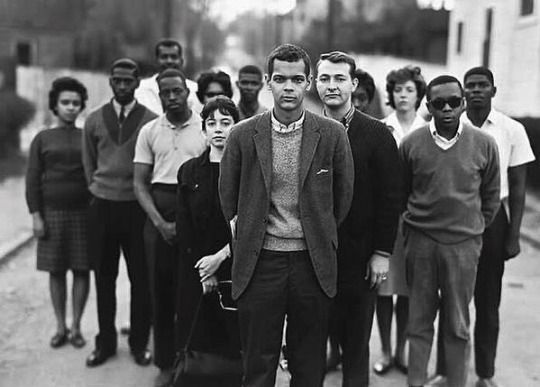
Today We Honor Julian Bond
Julian Bond was an activist in the civil rights, economic justice, and peace movements since his college years.
In 1960, Bond helped found the Student Nonviolent Coordinating Committee (SNCC) and earlier that year, he helped create the Atlanta University student civil rights organization, which directed several years of nonviolent protests and won integration of Atlanta’s movie theaters, lunch counters, and parks.
Bond served 20 years in the Georgia House and Georgia Senate, drafting more than 60 bills that became law. He was president of the Atlanta branch of the NAACP for 11 years and in 1998, was elected chair of the NAACP national board and served for 11 terms until stepping down in 2010.
CARTER™️ Magazine carter-mag.com #wherehistoryandhiphopmeet #historyandhiphop365 #carter #cartermagazine #blackhistorymonth #blackhistory #history #julianbond #staywoke
#carter magazine#carter#historyandhiphop365#wherehistoryandhiphopmeet#history#cartermagazine#today in history#staywoke#blackhistory#blackhistorymonth#julian bond
315 notes
·
View notes
Text
KWAME TURE BLASTS AFRICAN BOURGEOISIE
On this day in 1998, Pan-African revolutionary and icon Kwame Ture died in Guinea, Conakry. Born on 29 June 1941, Ture, formerly known as Stokely Carmichael, moved to the United States from Trinidad with his family at 11. He led a life marked by a strong dedication to the Pan-African cause. In his mid-20s, he became chairman of the Student Nonviolent Coordinating Committee (SNCC), which primarily focused on organising and mobilising Black people in the US South to exercise their voting rights. He later oversaw SNCC members who co-founded the Lowndes County Freedom Organization, an SNCC affiliate focused on registering Black voters in Lowndes County, Alabama. Ture was at the forefront of this struggle throughout the 1960s, from the Freedom Rides (challenging segregation at bus stops) to the rise of the Black Power Movement. He later helped found the All-African People's Revolutionary Party. The majority of Ture's last three decades were spent in the West African nation of Guinea, a testament to his commitment to Pan-Africanism. Here, he adopted the name ‘Kwame Tureaud in honour of Ghana's founding leader and Pan-African icon Kwame Nkrumah and Guinea's then-president Sékou Touré, two revolutionaries he drew a lot of inspiration from.
Despite becoming friends with many African leaders during his time on the continent, Ture never held back from calling out the worst tendencies of the African bourgeoisie. He pointed out that it was essential to understand that not all Africans are on the side of the masses and revolutionaries. In remembrance of this great son of Africa, here is a 1989 clip of him exposing the African bourgeoisie.
My comment: Bro Kwame, all I see are beautiful, black humans being corrupted into consumatronic zombies by Whiteness and capitalism. Until we remove that veil of idiocy and outright drunken adultery, Blk ppl will NEVER be free.
20 notes
·
View notes
Photo
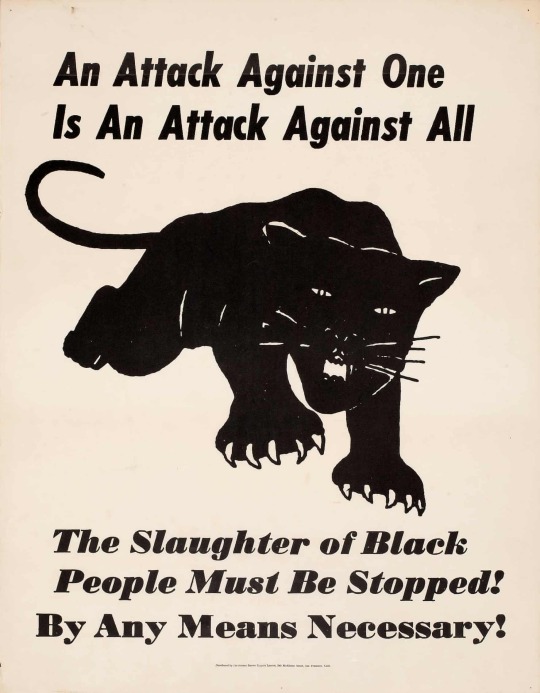
Power to the people: the branding of the Black Panther party
An Attack Against One Is an Attack Against All, 1968 Designer Unknown
The history of the logo can be traced back to designer Ruth Howard, a member of the Atlanta branch of the Student Nonviolent Coordinating Committee where she learned how visuals could galvanize a community. In 1966, SNCC organizers in Lowndes county approached her to create the symbol. Howard originally designed a dove to express power and autonomy but it wasn’t well received. She eventually based it on the school mascot of Clark College, a local HBCU. Dorothy Zeller, a white Jewish woman, added whiskers and the black color
Photograph: The Merrill C Berman Collection
#the merrill c berman collection#black panther party#an attack against one is an attack against all#poster#activism#history#student nonviolent coordinating committee#lowndes county#georgia#ruth howard#designer#dorothy zeller#clark college
95 notes
·
View notes
Text

Gordon Parks: Stokely Carmichael and Black Power, Edited by Lisa Volpe, Steidl Verlag, Göttingen, 2022 [© Gordon Parks / The Gordon Parks Foundation, Pleasantville, NY]








#graphic design#art#photography#catalogue#catalog#cover#stokely carmichael#kwame ture#gordon parks#lisa volpe#peter w. kunhardt jr.#student nonviolent coordinating committee#sncc#a aprp#all african people's revolutionary party#steidl#2020s
18 notes
·
View notes
Photo

On this day, 8 June 1961, a group of Freedom Riders were arrested in Jackson, Mississippi, including Kwame Ture, Gwendolyn Greene and Joan Mulholland (pictured, l-r). Freedom Riders fought government non-enforcement of the ban on segregation in public transport in the US South by riding in multiracial groups. They faced intense violence from local police and white supremacists, including the Ku Klux Klan, until eventually winning in December that year. Ture (born Stokely Carmichael) became a central organiser in the Student Nonviolent Coordinating Committee, and later the Black Panther Party. He was targeted by the FBI's COINTELPRO operation, and "bad jacketed" – falsely painted as a CIA agent and expelled from the SNCC. Greene (who later changed her name to Britt) had also been arrested in 1960 for refusing to leave the segregated Glen Echo Amusement Park in Maryland. With others, she confronted counter-protesters from the American Nazi Party and continued picketing until the end of summer. The park then agreed to abolish segregation before reopening the following year. Mulholland, then aged 19, had participated in numerous civil rights sit ins, for which she was disowned by her family. In 1963, she was travelling with four other activists in Mississippi when their car was attacked by the KKK, who had orders to kill them, but they managed to escape. Mulholland remains active to this day. Image from the excellent @ZinnEducationProject More information, sources and map: https://stories.workingclasshistory.com/article/10819/freedom-riders-arrested https://www.facebook.com/photo.php?fbid=640538474786038&set=a.602588028581083&type=3
230 notes
·
View notes
Text
by Dion J. Pierre
Harvard University denounced an antisemitic image depicting a Jew lynching an African American and an Arab which was posted on social media by an anti-Zionist faculty group.
“The university is aware of social media posts today containing deeply offensive antisemitic tropes and messages from organizations whose membership includes Harvard affiliates,” the university said, speaking from its Instagram account. “Such despicable messages have no place in the Harvard community. We condemn these posts in the strongest possible terms.”
Harvard Faculty and Staff for Justice in Palestine (FSJP), a group which describes itself as a “collective” committed to falsely accusing Israel of genocide and dispossession — terms one finds on the fringes of the extreme right — initiated this latest controversy. The image it shared shows a left-hand tattooed with a Star of David containing a dollar sign at its center dangling a Black man and an Arab man from a noose. In its posterior, an arm belonging to an unknown person of color wields a machete that says, “Liberation Movement.”
“African people have a profound understanding of apartheid and occupation,” says a graphic in which the image appears. “The historical roots of solidarity between Black liberation movements and Palestinian liberation began in the late 1960s. This period was marked by a heightened awareness among Black organizations in the United States.”
It continued, “The Student Nonviolent Coordinating Committee [SNCC] linked Zionism to an imperial project while the Black Panther Party aligned itself with the Palestinian resistance, framing both struggles as part of a unified front against racism, Zionism, and imperialism.”
On Monday, Harvard Faculty and Staff for Justice in Palestine — whose 112 founding members include professors Walter Johnson, Jennifer Brody, Diane Moore, Charlie Prodger, Leslie Fernandez, Khameer Kidia, and Duncan Kennedy — apologized for sharing the image and suggested that it was unaware of its own social media activity.
“It has come to our attention that a post featuring antiquated cartoons which used offensive antisemitic tropes was linked to our account,” the group said. “We removed the content as soon as it came to our attention. We apologize for the hurt that these images have caused and do not condone them in any way.”
Two other student groups have apologized for sharing the image, according to The Harvard Crimson. In a joint statement, the Harvard Undergraduate Palestine Solidarity Committee and the African and American Resistance Organization said “our mutual goals for liberation will always include the Jewish community — and we regret inadvertently including an image that played upon antisemitic tropes.”
The past four months have been described by critics of Harvard as a low-point in the history of the school, America’s oldest and, arguably, most prestigious institution of higher education. Since the October 7 massacre by Hamas, Harvard has been accused of fostering a culture of racial grievance and antisemitism, while important donors have suspended funding for programs. Its first Black president, Claudine Gay, resigned in disgrace last month after being outed as a serial plagiarist. Her tenure was the shortest in the school’s history.
As scenes of Hamas terrorists abducting children and desecrating dead bodies circulated worldwide, 31 student groups at Harvard, led by the Palestine Solidarity Committee (PSC) issued a statement blaming Israel for the attack and accusing the Jewish state of operating an “open air prison” in Gaza, despite that the Israeli military withdrew from the territory in 2005. In the weeks that followed, anti-Zionists stormed the campus screaming “from the river to the sea, Palestine will be free” and “globalize the intifada,” terrorizing Jewish students and preventing some from attending class.
In November, a mob of anti-Zionists — including Ibrahim Bharmal, editor of the prestigious Harvard Law Review — followed, surrounded, and intimidated a Jewish student. “Shame! Shame! Shame! Shame!” the crush of people screamed in a call-and-response chant into the ears of the student who —as seen in the footage — was forced to duck and dash the crowd to free himself from the cluster of bodies that encircled him.
The university is currently being investigated by the US House of Representatives Committee on Education and the Workforce. It was recently subpoenaed by the body after weeks of allegedly obstructing the inquiry.
#harvard#harvard university#hamas#gaza#palestine solidarity committee#antisemitic image#antisemitism
24 notes
·
View notes
Note
Hi! Your "talking about wheelchair blues" post made me curious if you know any disabled folk singers?
Yea, there are actually tons!
in the early blues, there were many blind artists.
Blind Blake (1896-1934) Blind Willie Johnson (1897-1945) Blind Lemon Jefferson (1893-1929) Blind Willie McTell (1898-1959) Bo Carter (1893-1964) Sleepy John Estes (1899-1977) Blind Boy Fuller (1907-1941) Cortelia Clark (1906-1969) Rev. Gary Davis (1896-1972) Roosevelt Graves (1909-1962) Sonny Terry (1911-1986)
there's also cisco houston, whose eyesight was so poor that it rendered him legally blind by the end of his life.
and then, of course, there was woody guthrie who suffered from Huntingtons disease.
A LOT of traditional folk singers were disabled but that fact about them was not mentioned or only mentioned as an afterthought, or it isn't considered a disability. it would be very hard to compile all of these people.
and, as classic artists like pete and peggy got and get older, they both talked more about disability rights and how they affect them, peggy seeger is 89 currently and still making music. both she and Pete have either performed songs like disability in solidarity with disabled people or made music about how being disabled relates to them.
THEN, there's the Disabled In Action (DIA) singers. much like the Freedom Singers of the Student Nonviolent Coordinating Committee (SNCC), the Disabled in Action singers were a musical group that made and covered songs that were about disability rights and disability made upof members with from the DIA organization. the DIA is a grassroots civil rights organization focused on ending discrimination against Disabled people, founded in 1970, in NYC.
the folks of the Disabled in Action Singers were not very well known, and the only one who was, was Sis Cunningham, who joined the group in her eighties.

luckily for us ! they have all their recordings available on their website.
here's some fun live performances i found as well of songs either by the DIA singers or by other people about disability
youtube
youtube
There is definitely more and I'll reblog this whenever I find more disabled folk artists. if anyone knows any contemporary disabled folk artists feel free to reblog this as well. I know that people in the folk-punk scene have been making music about disability.
#folk#disabled folk#folk music#disability history#disability activism#disability rights#disabled#crip punk#cripple punk#american folk revival#folk revival#american folk#blues history#blues artists#american blues#blues#op is disabled#queer cripple#protest folk#struggle folk
9 notes
·
View notes